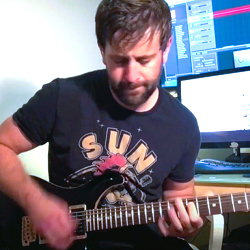Major Pentatonic Scale Exercises with Alternate Picking Patterns
Learn and memorize three of the most common major pentatonic scale shapes.

Alternate picking and pentatonic scales tend to make a happy marriage.
Since the major pentatonic scale, in particular, can so easily be broken up into dyadic intervals (notes grouped in twos) on each string, applying an alternate picking pattern is simpler than if we were dealing with triplets (notes grouped in threes). Thus, we’ll use pentatonic scales to intentionally work on refining our alternate picking technique.
This is also one of the most effective ways to build speed, particularly if you’re in the early stages of learning guitar, though it can apply to (and benefit) any skill level.
For these exercises we’ll go line by line through three common major pentatonic scale guitar patterns, in three different keys. Our alternate picking technique will allow us to work on building speed while memorizing useful scale patterns.
The goal of this lesson is three-fold:
- Learn and memorize three of the most common major pentatonic scale shapes
- Understand and refine the alternate picking technique
- Build speed over dyadic, repeating interval patterns
First Pattern: A Chord Shape in the Key of C
To start, we’ll use the A chord shape pattern in the key of C, which I would consider the easiest of the major pentatonic scale shapes. Let’s look at the tab first, without the alternate picking indicators:

I’ve used 16th notes to get the “feel” of playing faster, and to keep everything within the same measure. For the next few diagrams, I’ll fill out the last four notes by descending back down the scale.
Play through the shape at whatever speed you’re comfortable with, and pay attention to how you’re handling the picking with your right hand.
To alternate pick this pattern, you should be alternating between down and upstrokes of the pick for each note. Here’s what the tab would look like with those indicators included:

The squared off symbol indicates a downstroke, while the triangular shape indicates an upstroke of the pick.
Since the goal of alternate picking is to handle scales and lead segments more efficiently (build speed), let’s listen to the above tab at 120 BPM.
It’s quick, but it’s attainable with the major pentatonic scale’s structure, especially if we’re properly utilizing the alternate picking technique. Let’s listen to the same tab at 80 BPM
And again at 55 BPM:
For me, 16th notes at 55 BPM is a pretty good starting point, at least if I’m focusing on a right hand picking technique. Once you can reliably alternate pick through that shape, use it as an exercise to speed up and get closer to those higher BPMs. While I never recommend memorizing scales without some kind of melodic creativity in mind, it is extremely helpful from a practice and speed-building perspective.
Let’s try another slightly more difficult pattern.
Second Pattern: E Chord Shape in the Key of G
I’ve used the key of G for this pattern so our root note lands on the low sixth string at the third fret, which is a convenient place to start our scale.
Keep in mind, shapes like these are moveable to any part of the fretboard, where the key would change, but the shape and intervals (fret distance between notes) would stay exactly the same. This shape is more challenging than our first pattern, simply because the intervals on each string are not nearly as uniform.
We’ll start with the same alternate picking pattern, using one downstroke and upstroke for every two-note interval:

Again, our down and upstrokes are evenly distributed across each string. Notice that the interval distance differs on the second, fourth and third strings, which is where you’ll want to focus as you start memorizing the shape.
Practice running through slowly, in the indicated alternate picking pattern, just like we did for the previous major pentatonic scale shape.
For reference, here’s the above tab at 55 BPM.
Once you’re familiar with the differing interval patterns and you can alternate pick through the scale without any mistakes, we can up the speed to 80 BPM.
And once more at 120 BPM, just so you have a reference for what the faster alternate picking pattern would sound like in this scale:
Just as we did with the first pattern, use the scale as a grid on which to build up your alternate picking speed. You can move the pattern to different frets if that helps you get a better handle on the movement.
Third Pattern: C Chord Shape in the Key of D
Our last example is the most difficult of this list, though it should still be a fairly easy and familiar pattern to follow. This segment is in the key of D, placing the root on the fifth string at the fifth fret. Take your time getting used to the pattern, taking care to maintain a back and forth alternate picking motion.

Now that you’ve gotten used to alternate picking and a couple major pentatonic scale guitar shapes, you might be able to move through this one a little quicker. Start by trying to keep pace with this audio, which is the above tab at 70 BPM.
Of course, the speed at which you’re able to maintain correct notes and proper alternate picking technique is variable. It won’t be the same for everyone and the audio samples aren’t meant to contradict that. If you can’t keep pace with them, don’t hesitate to set your own pace and work your way up to those speeds.
I’m using them to give you an idea of what proper alternate picking at those higher speeds can and should sound like. It gives you a target to aim for.
If you don’t hit it right away, that’s not a big deal.
In Conclusion
These exercises gives you a really clean and concrete way to apply a certain type of scale. I’m not a fan of mindlessly memorizing scale shapes without some kind of purpose behind it. Because scales, in and of themselves, don’t accomplish anything. They’re structural and means to an end, but not the end on their own.
In this case, we’ve taken a type of scale—the major pentatonic—isolated certain patterns and used those patterns to develop a particular skill and technique.
That means we get the benefit of the new structure (the scale), improve on a valuable technique (alternate picking) and develop an applicable skill (improved speed).
Bobby is the founder of Guitar Chalk and a contributor to Guitar World. You can hit him up on Twitter</a> or shoot him an email to get in touch</a>.
Get The Pick Newsletter
All the latest guitar news, interviews, lessons, reviews, deals and more, direct to your inbox!
Bobby is the founder of Guitar Chalk, and responsible for developing most of its content. He has worked with leading guitar industry companies including Sweetwater, Ultimate Guitar, Seymour Duncan, PRS, and many others.
“There are so many sounds to be discovered when you get away from using a pick”: Jared James Nichols shows you how to add “snap, crackle and pop” to your playing with banjo rolls and string snaps
Don't let chord inversions bamboozle you. It's simply the case of shuffling the notes around








![Joe Bonamassa [left] wears a deep blue suit and polka-dotted shirt and plays his green refin Strat; the late Irish blues legend Rory Gallagher [right] screams and inflicts some punishment on his heavily worn number one Stratocaster.](https://cdn.mos.cms.futurecdn.net/cw28h7UBcTVfTLs7p7eiLe.jpg)


